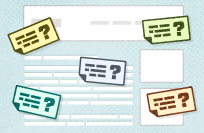Community Embraces New Word Game at Mid-Year Play Day This past Sunday, families at Takoma Park’s Seventh Annual Mid-Year Play Day had the opportunity to experience OtherWordly for the first time. Our educational language game drew curious children and parents to our table throughout the afternoon. Words in Space Several children gathered around our iPads […]
Read more Make sure your investments on web sites, apps or new real-life programs don’t fail by conducting usability and user experience testing.
Make sure your investments on web sites, apps or new real-life programs don’t fail by conducting usability and user experience testing.
“Usability testing differs from focus groups in that it involves the observation of participants as they actually use the product,” said Ian David Moss, a development consultant who works in the Arts. “They key feature of usability testing that makes it different from most other kinds of feedback-gathering methods is that it is based on direct observation rather than self-reporting….So, rather than have people sit around a room and talk about (for example) how they might react to a new feature or what challenges they face in their daily work, you have people sitting in front of a computer and trying to navigate a website’s capabilities while staff members look over their shoulders and take notes.”
To do testing… see my recent post about usability testing vendors and systems.
In addition to collecting user feedback with testing, there are other approaches to good usability:
- Intuition (instinct) – Idiosyncrasy is valuable. Create a site or app that you really like, while also trying to think about how outsiders and users will perceive it. Try to clear your mind (for a fresh look) and ask yourself how you would want it to work. Many of the biggest ideas, e.g., Facebook, and many products from Apple started this way.
- Casual testing – You can catch the majority of usability problems by testing with just a few people. Use your friends, family and colleagues as Guinea pigs — and ask them for quick 5- minute feedbacks.
- Heuristics (abstract theories) – Follow a series of rules and best practice guidelines. Jakob Nielsen’s list of ten heuristics are a famous starting point, but there are many variations. Apple also has a classic list of human interface guidelines for engineers. Heuristics are useful framework and checklist, but merely following heuristics misses the forest for the trees.
- Tracking – Review statistics of what they click and tap. Services like Google Analytics show the most popular pages, and the sequence users take. Review this to make sure that important screens are reached, and that there are not deadens. Eye tracking and heat maps are also useful to make sure that important parts of your design are not totally ignored.
- Accessibility – Make sure people with different abilities (e.g., blind, or with cataracts) can user your resource. Often this means adjustable font sizes, or including audio versions.
- Internationalization – Adding translations/localizations for users to who don’t read English. Mandarin Chinese is the most widely spoken native language, followed by Spanish, English, Hindi-Urdu, and Arabic. See a list of languages by number of native speakers at Wikipedia for a reality-check about how many non-English speakers there are on earth.
These concepts apply to programs (e.g., real-life outreach projects) as well as web sites and apps. Arts management consultant David Dombrosky said, “I love the idea of re-contextualizing “usability testing” as a feedback mechanism for arts audiences. As with online usability testing, the devil will be in the design, but the concept is well worth pursuing.”


25 Oct 2011, 7:06 am
[…] are some approaches to good usability from Idea.org . Read the full post is […]